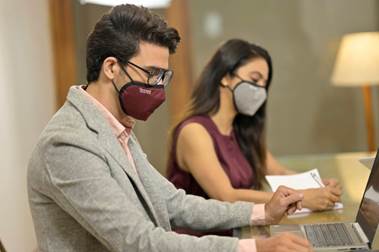Hailed by many as the “wonder material” of the 21st century, the applications of graphene are limitless, ranging from electronics to filtration and from energy to construction, and from coating to sensors. However, it is the antimicrobial nature of graphene for textiles that has captured the imagination during this ongoing pandemic.
In the last few decades, the two-dimensional wonder material called graphene has grabbed the attention of researchers due to its tuneable electronic properties and promising applications which include antimicrobial activity or sensors to detect drug-resistant bacterial infections.
Graphene, due to its superb characteristics, gives an extremely versatile advantage to almost every industry ranging from the manufacturing of airplanes to making medical sensors, from the filtration membranes for air and water to providing strong antimicrobial properties for textiles. It also gives superlative energy storage upgrades to batteries, super-capacitors and hybrids.
The most well-known property of graphene is that it is one of the strongest materials on the earth. It is only one atom thick, i.e. one-thousandth of the thickness of human hair, has strong antimicrobial activity, high electron mobility and thermal conductivity at room temperature, along with high flexibility.
Graphene, due to its antimicrobial activity, has emerged as a blessing during this pandemic. The unprecedented outbreak of the SARS-CoV-2 coronavirus is tearing global health systems apart. While government bodies are trying their best in preventing the spread of covid-19, various vaccination drives against the novel coronavirus are under way across the globe.
The incorporation of graphene with textiles such as cotton, polyester and nylon as coatings improves the strength of fibres besides imparting anti-static properties. Graphene’s hydrophobicity limits the adhesion and growth of microbes on the surface of fabrics. Therefore, it helps in producing an anti-microbial textile, not only limiting a micro organism’s settlement on the surface but also representing a clean and dry surface. Due to this ability, it becomes an important material in medical applications.
Since graphene is a single layer of carbon atoms connected in a hexagonal pattern, it is extremely thin and lightweight, and therefore an attractive material for nanotechnology applications and is widely used in the nanotech industry. Though graphene is at the nascent stage if we talk in the Indian context, it has been attracting the attention of technologists and researchers for decades due to its impressive ability to store electric charge—its capacitance. This property is largely derived from graphene’s very high amount of surface area relative to its volume.

Graphene can be used to make technical textiles, using graphene composite at the fibre stage or yarn stage or even at the fabric stage. This technology can be used on both natural fibres and synthetics. After rigorous R&D, graphene’s unique synthesis formula with silver nanomaterials was invented and it showed strong anti-viral and anti-bacterial activity. The atomically sharp edges of graphene act as nano-knives that have the ability to damage the outer wall of microbes.
Also, silver nanoparticles produce reactive oxygen species (ROS) in oxidative conditions and can attack external enzymes and proteins leading to irreversible damage to the genetic material of viruses and bacteria. So, graphene is widely used in the textiles industry, especially for surgical-based textiles.
Graphene has been hailed by many as the “wonder material” of the 21st century, especially for nanotechnology applications. The applications of graphene have no bounds. This wide-ranging application of graphene in every field is because of the outstanding properties of the graphene sheet.
In the prevailing pandemic, face masks have become an important tool in fighting against the SARS-CoV-2 virus. However, improper use or disposal of masks may lead to secondary transmissions. Most of the masks that are available in the marketplace today have been crafted on the principle of filtering out the microbes, thus restricting them to enter our eyes, nose and mouth. Moreover, the safety of health workers has been a prime concern; they need to be provided with high quality protective equipment.
Keeping this in mind, many researchers around the world have come up with various solutions. Among them is the idea of incorporating graphene into masks, gloves and gowns for medical staff. The coating of graphene or incorporation of graphene in a polymer matrix has the power to limit the virus transmission danger by killing within seconds 99 per cent of the virus that come in contact with the membrane. When tested as per the ISO 18184 protocol, anti-viral testing against the SARS-CoV-2 virus showed a 99 per cent reduction and kill rate of 99 per cent in just a matter of seconds. Researchers have also come up with graphene-based equipment for detecting and fighting the novel coronavirus.

The graphene-silver technology could be used as an alternative anti-biofilm agent without the adverse effects of microbial resistance, more frequently attributed to antibiotics, disinfectants and other conventional agents. Most important, unlike common disinfectants, this coating does not lose its activity with time because of its unique nano-architectural properties.











Comments